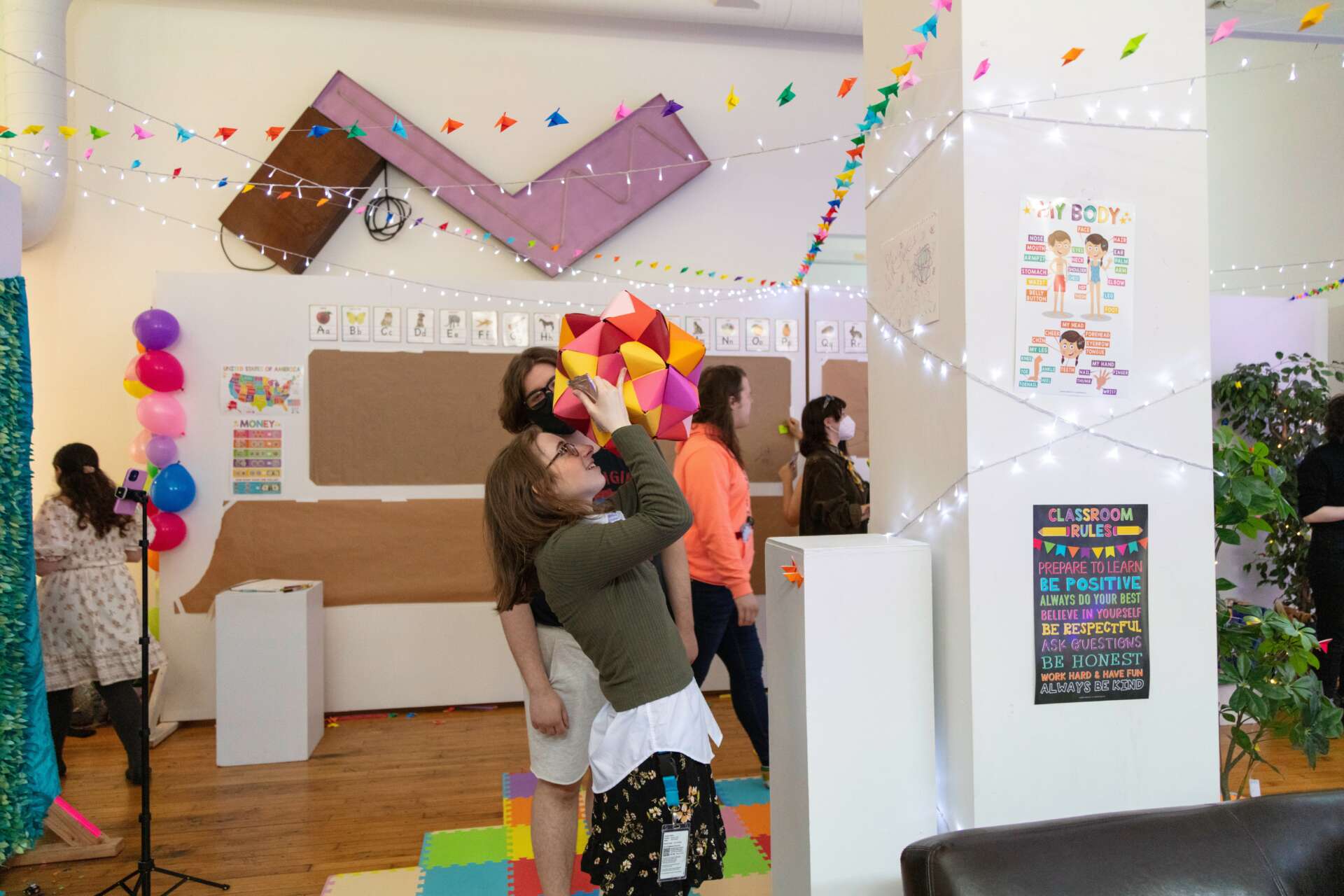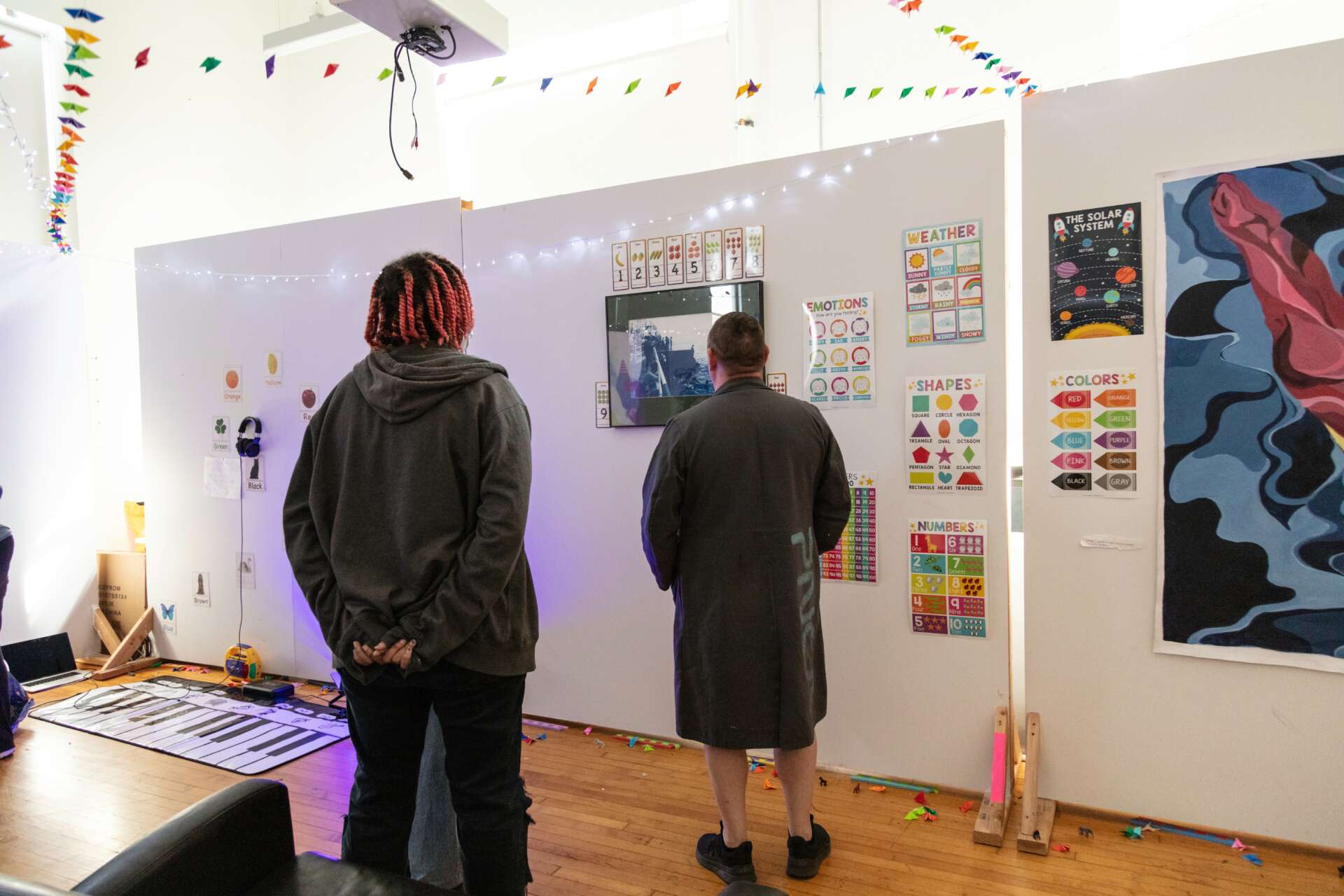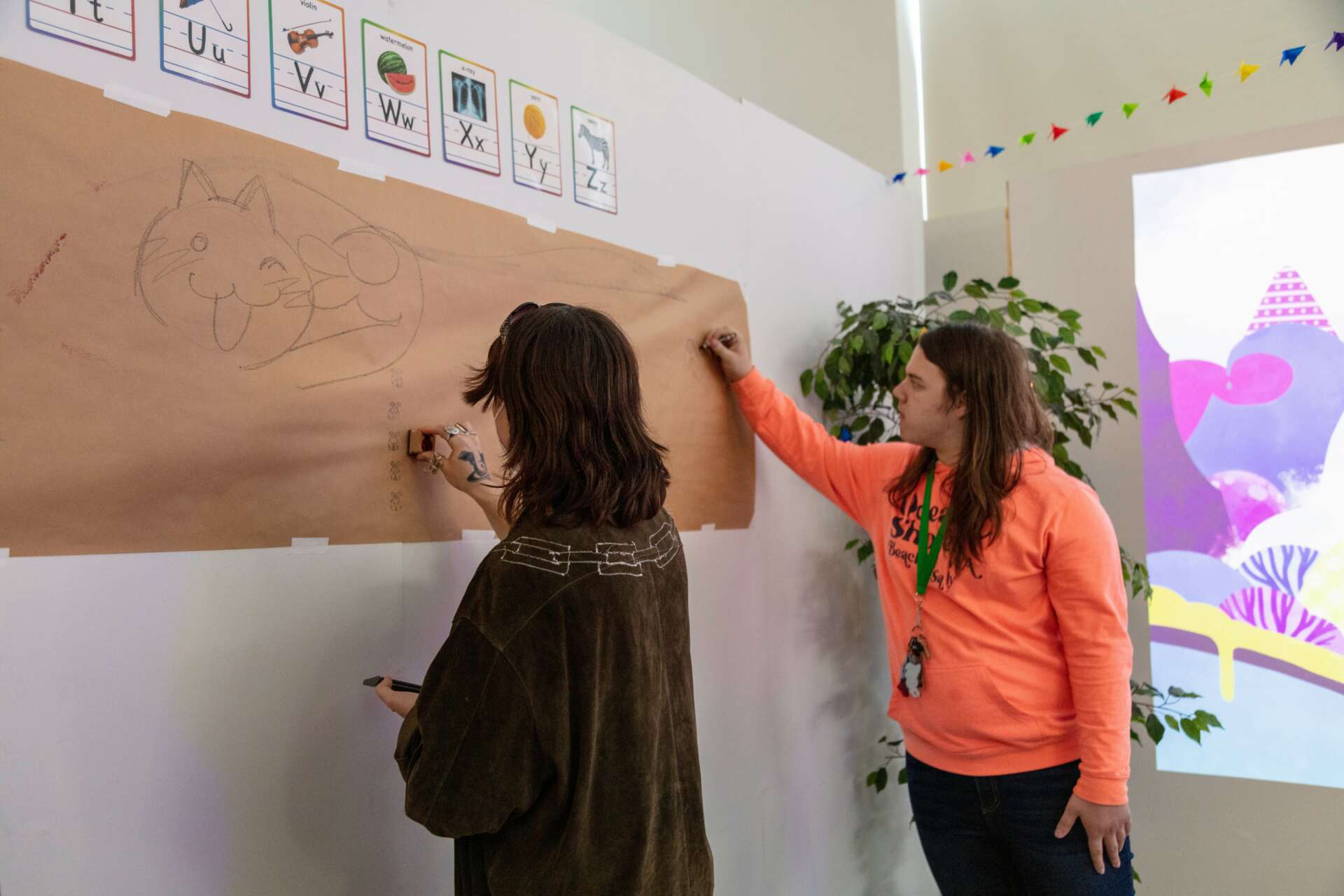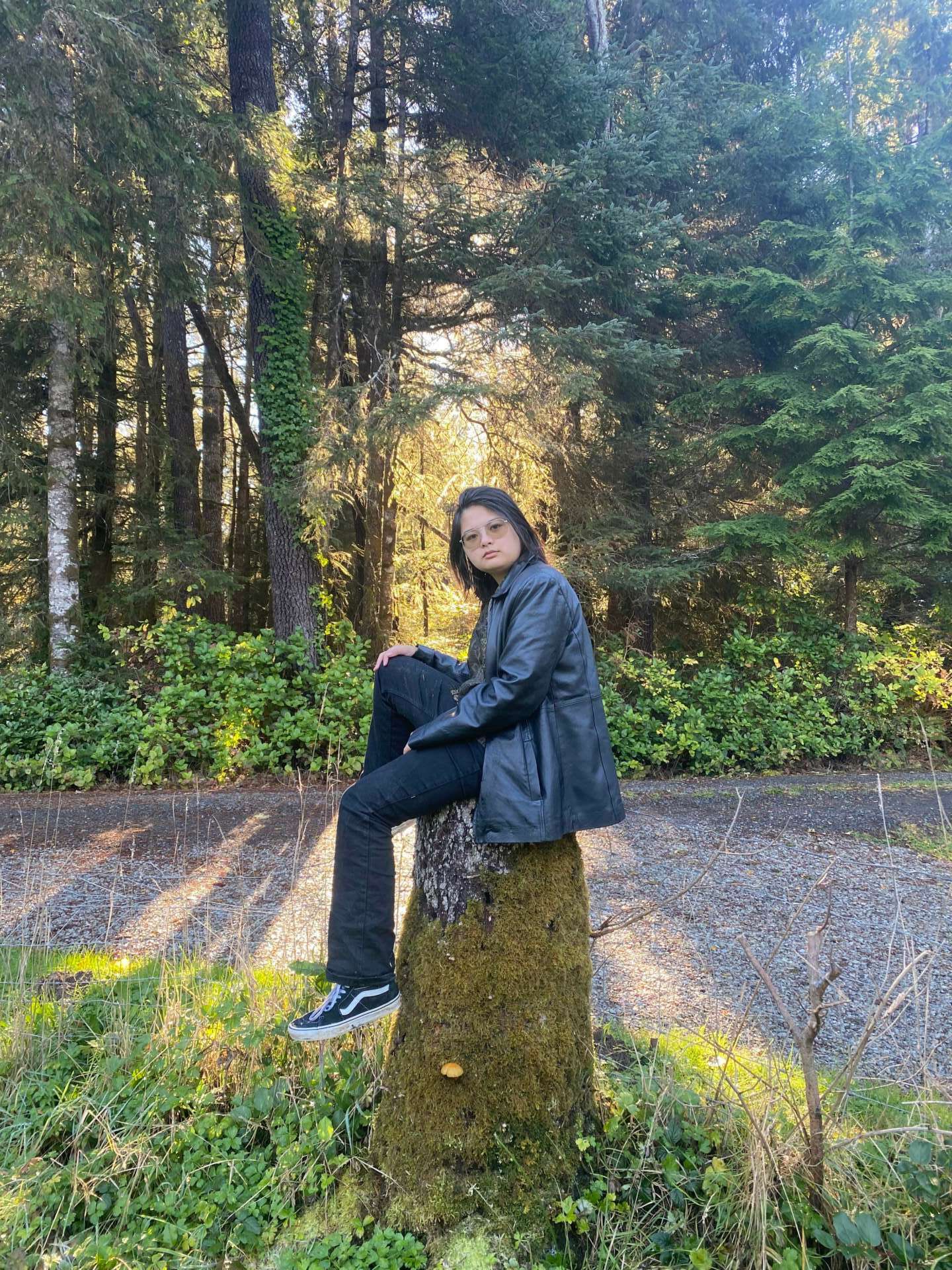We caught up with the brilliant and insightful Ozias Lapsys a few weeks ago and have shared our conversation below.
Ozias, looking forward to hearing all of your stories today. Can you talk to us about a project that’s meant a lot to you?
“Play Space” initially began as a school project.
I took Theory & Practice: Art in Context taught by Melanie Stevens in Spring of 2023 not really expecting much of it. The class was described as “interdisciplinary, research-oriented studio course that foster an idea-based, non-media specific inquiry focusing on concerns within and outside the visual art.” Breaking that down from all the artistic jargon, I decided that I essentially knew nothing about the class except that it’d probably be reading or lecture-heavy with minimal art and had no required medium in the event that I happened to make art.
I would find that I was partially correct except for the bit about the lectures. The class was heavy with many readings but we also had many discussions and I found that despite all of the work, I was engaged every time I came to class. For me personally, this is a rare feat. I am not one to enjoy classes that are often heavy with research because I find that most of my teachers growing up have been people who cared far more about how we presented and curated ourselves rather than the content itself. My childhood was spent regurgitating information I didn’t care about. In Melanie’s class, I was pleasantly surprised to be met not only with content that I cared about but that Melanie did as well. She was passionate about the class and the content within it and in turn, the students were too. It was a very refreshing class to have during my freshman year of college after so many years of being disappointed with the classes I took.
The class had three projects in total. Although I didn’t know it yet, Play Space began during the second. The second project was essentially to create and present a mock exhibition proposal involving one of my classmate’s works of art. Through interviews conducted with my assigned peer as well as Melanie’s instructions, I would form a proposal called “Sandcastles: A Journey Home.”
At the time, I was exploring ideas of nostalgia, and having been exploring what a gallery space meant in terms of everything from class to culture, I decided that a white box gallery was not at all what I wanted. Drawing from the inspirations of my classmate Dot Grover, the works of one of their biggest inspirations, Brigitte Coovert, and my own fascination, Emmanuelle John, from the group Meow Wolf, I created a fictional exhibition exploring the idea of returning to a place of nostalgia and the grief and joy that comes with acknowledging your personal relationship with the subject. The fictional exhibition detailed how I wanted the work of Dot to be transformed into large sculptural works that might be interacted with in the Lloyd Center in Portland, Oregon. The presentation was a big success with my class and I found that my classmates were continually complimenting me on the project. I was very stressed about the project at the time to the point of bugging my roommates about it and being late to the class and so I was overjoyed when I found out we’d actually be able to make an exhibition.
This leads me to our third project: the exhibition. Melanie’s third and final project within the class happened to be curating and hosting our own exhibition. I am not one to pass up opportunities so when I heard this, I was absolutely elated that our class would be culminating with something I thought of as so huge. I knew I needed to do something big and so we got to work. The class was divided into two so there would be two different exhibitions and each exhibition was inspired by the prior mock exhibitions we had done.
The artists included in my group (who would inevitably become the artists I worked with) were as follows: Mandy Tran, Samuel Densmore, Steele Alden, Sydney Haswell and Q Savoy.
To my complete joy, my group designated me with the role of curator (though I think they knew I very obviously wanted to be) and to my even greater joy, they decided to choose my mock exhibition as the inspiration for the exhibition we were going to do. Since I had already made the mock exhibition, we met our first challenge of trying to figure out how to expand upon the idea I had already put so much effort into. I think we managed well though and instead of changing what already worked, my peers narrowed down my ideas into something much more consumable. We decided that we should keep the theme of nostalgia but instead of walking into a space that acted as a representation of imagination, we decided to turn our space into a memory we all commonly shared: a kindergarten classroom.
Our decided exhibition space was a storage space on the first floor of PNCA that Samuel, Steele, Q and I had used for a previous project in the same class and so we thought that’d be the perfect spot since we were already nostalgic about the space. We decided to transform it into a kindergarten classroom (or something adjacent) with foam floor tiles, a play rug for kids, and many other things we thought we’d enjoy in kindergarten. Each artist made a piece representing something that was nostalgic to them and soon we had our exhibit.
There were a lot of challenges along the way.
All of Play Space’s ideas were contained in a Google Drive and this led to most of our communications being through email. This was a big uh-oh as the pros would say. I felt like because all of our communications were through email, this led to me getting information and sending it a lot slower than I should have. It was only really a big issue when we had to show our proposal to Melanie who had little to no information on what my artists wanted to make because I didn’t know all of the details of it or the day of set up when I had to go home due to health issues causing me to be unable to walk but it was still enough that I noticed. Another issue I had was with budgeting. All of the budget for Play Space was funded by the PNCA’s Student Activity Fund managed by Student Life and the Student Council. The rules of the activity fund are unfortunately set in stone and due to this, for any budget over 250, we have to wait 1-2 weeks to vote on it depending on how much it is. Due to the timing of Play Space, we unfortunately submitted the request before a week when we wouldn’t have classes so if I recall correctly, the budget was pushed longer than it normally would have been had we had classes.
Other than those lessons, there weren’t many challenges. All of the artists participating contributed in such a large way and were so wonderful. I was so lucky to have such self-sufficient, committed artists involved in this project. I remember coming to school to help set up a day or two before our exhibition started and finding Sam on the floor, threading together a thousand paper butterflies they made to hang up. I also remember when he inevitably told me I should go home because I was in pain and finished hanging up the butterflies himself (which I appreciated greatly). After the show, I remember seeing Sydney and Mandy as well as pulling apart the exhibition during Spring finals which was a huge help. I was super appreciative when I walked in and saw they had done most of the work unbeknownst to me.
The day we hosted Play Space was the most magical though. It was so much fun seeing people come and interact with the space and talk to each other. We had pizza there and a lot of snacks which is why I think most people came but even then when there was no one left and the space was open for two days, I felt very happy just being able to sit and eat lunch alone on the couch in there during my finals. It was probably the most rewarding project I’ve done for any class and by far the best collaborative project I’ve done. I hope I did my peers work justice with my vision as a curator.


Ozias, before we move on to more of these sorts of questions, can you take some time to bring our readers up to speed on you and what you do?
My name is Ozias Lapsys and I am an Intermedia student currently attending the Pacific Northwest College of Art.
Considering I am rather young, my life in art has been pretty short and therefore has been defined predominantly by the classes I took throughout my schooling. I’d like to think that since I was little I’ve been surrounded by art. My father was a Renaissance man who seemed to know everything about architecture despite not ever actually using his degree and my mother was a lover of anything related to the stage. I have fond memories of my dad’s oil paintings in lingering in the empty spaces of our first house. My grandfather collected masks from around the world and my grandmother was fond of the little details in any object. She is a very curated woman in all areas. I have been very lucky to spend my life living in a space where everyone I knew seemed to be picking up art in one way or another.
I think the first person that really influenced my art was my brother.
My younger brother is someone I admire a lot. He’s a very direct type of guy and he’s not afraid to tell you when he thinks you’re wrong. Growing up, he played a lot of video games. It sounds stupid but I was always too anxious to play—afraid that I might not be as good as him or letting my perfectionism eat at me until I just hated the game I was playing—so I would sit idly by watching him. He’s really good at games. Growing up by his side and watching him wander through these worlds I could never really breakthrough, I saw something I could make.
I think it was then I decided I wanted to make a game that he could love.
Games were only a means to an end. I started by making board games. They were really haphazard at first. During the summer, my brother and I would go to my grandparent’s house and steal printer paper to draw on. I remember cutting out tons of different characters and making my own poorly taped-together boards in hopes that my family would be interested enough to play. My dad eventually taught my brother and I how to play Dungeons and Dragons and that was the beginning of the end.
As my brother delved more into video games, I dropped down into the vast world of text-based or spoken RPGs. I loved the idea of a game that was ever-expanding and that could be shaped by those who interacted with it. It’s infinite not because of its foundation, but because it can always be changed with every generation. I loved the idea of the audience being able to directly affect and change the worlds I produced and eventually become more than just an audience. It was only ever inevitable that I fell in love with interactive art.
These days, I’m still not a professional artist. I don’t sell anything or post online (anymore) like many of my friends do and I don’t think I will in the near future. I am still looking for something special to create in order to tell the stories I want to tell in the way I want to tell them. I don’t know what it will be but in the meantime, I’ve been trying a lot of different things. I have been playing with the ideas of physical galleries through the form of the interactive art exhibit I curated called Play Space as well as picking up skills like coding in hopes of returning to the initial idea of making a game. So there you have it. I’m just an artist in the making.

Can you tell us about a time you’ve had to pivot?
Call it growing pains or call it pivoting but at this current moment in time, I am changing what I am doing in order to better suit my needs.
Growing up, my art (and life for that matter) was shaped by everything that surrounded me. For most, this would be completely natural although, in my experience, it was anything but. I spent my childhood being force-fed art from the internet. My world was a perfect echo chamber crafted by algorithms designed to keep me on their platforms for as long as they possibly could regardless of my well-being.
I was absolutely convinced that the only way for me to feasibly manage success as an artist was through posting my work publicly to gain a following that could sustain me for as long as I kept churning out new things. I looked to professional artists as the standard and then to my own art and decided that what I made was absolutely not good enough to be marketed and sold. This led to me ending up in a cycle of consuming endless tutorials in an attempt to push my work to be “better” and “marketable” which led to frustration when I couldn’t manage to immediately produce a decent output or meet a certain quantity of work that was way over my head and then convincing myself that the reason I could not produce the desired outcome was because I simply was not good enough so I turned back to tutorials.
Over the last two years, I’ve almost stopped making art completely simply due to my own burnout and exhaustion. Thanks to many different factors, I have been drained to the point where picking up paper and trying to put something—anything—has become a hassle. It got to the point where I almost decided to quit art and even now, I’m asking “If it’s so painful, why not just do it?”
Well, I’ve decided that I just don’t want to quit art. The first lesson I am learning during this time of change is that there is no shame in quitting. None. If I were to quit art right now, it wouldn’t be of any consequence. I am only 20 years old so if I wanted to return to it, I could. The idea of quitting art is so scary to me though, I don’t think I could manage it without feeling like I’ve lost a great part of myself. So that leaves me with one other option. The only option I have is simply to face the fact that art is something that is becoming hard for me to make and that sucks a lot. I am managing though. I haven’t stopped creating, thankfully, but I have changed how I treat it. I’ve decided that I don’t need any more tutorials about art and that I should actively avoid apps that will distract me from creating with methods of how to create. I’ve decided that I no longer want to be active on social media or any platforms that have limited me from creating to my fullest extent.
Essentially, I’ve decided that regardless of the consequence, I need to get rid of social media apps I am active on to diminish my usage of them and make space for me to explore my art from what is essentially ground zero. Of course, I am not that strict with myself. I used to think that having a social media cleanse was insane because it’s the only way I can connect with most of my friends since I’ve moved so much but it’s not as bad as I thought it was. Most of my friends are so busy anyway that we no longer communicate the way we used to. Whereas when I was younger, I’d spend hours online just talking to them, my friends have gotten older with me and now most of us can’t communicate until the workday is over anyway. As for more practical use of social media, I work as a Social Media Assistant for the Pacific Northwest College of Art which prevents me from getting rid of apps like TikTok and Instagram because I need them for work. Even then I am still able to limit my usage which I’ve found has helped my art immensely. I have deactivated all of my Instagram accounts on the basis that I don’t post much on my personal accounts anyway and on the side of TikTok, I’ve limited it to only one account which I mostly use for keeping up with trends I enjoy that way I can take inspiration from them for work.
I’ve found a bit of success in this. Although my discipline isn’t the greatest and I admit I have fallen back into the habit of watching tutorials out of curiosity, I’ve found that when I turn off my phone and create without fear of my marketability that I make things best.
I think this is definitely a larger cultural and generational issue that I cannot simply blame on phones. To some extent, my access to this wider range of knowledge has expanded upon ideas and tools I could not previously access. I have met people from different countries and lives that I would not have otherwise known if not for the technology we have today. On the same token, I have found that terrible events in my life have led to me pulling into myself more and burying myself on these apps in order to find some semblance of understanding. I feel more alone knowing that I’ve equated my worth as an artist to my financial success and my understanding of success is drawn from my experiences related to that making it hard to understand how to actually be successful. Perhaps to some degree, my reaction to the current economic climate and personal state of finances has affected the way I perceive my art. I digress.
At the end of the day, I’ve found that having real experiences and being offline more has improved my quality of life and, by extension, my art.

Are there any books, videos or other content that you feel have meaningfully impacted your thinking?
As our issues with climate grow more prevalent, I find myself leaning more into the need to understand the world around me. Often, I wish I was given time to go back to elementary school and to plead my teachers for a better understanding in math and science so that I could better express myself now as a young adult. These days, to cope with my lack of understanding, I fill my life with all types of media that could help me understand the impact my actions have on the environment.
One book that completely changed the way I look at my art was the book Cradle to Cradle by Michael Braungart and William McDonough. I was first introduced to Cradle to Cradle by my professor Michael Rodgers in his class Philosophy of Sustainable Design at the Pacific Northwest College of Art. The book describes the industrial and manufacturing systems as well as their impact on the environment and the need to integrate sustainable designs into our current industrial infrastructures. I feel anal whenever I discuss my ideas about sustainability at such a young age because I do not have the money (or drive to get the money) to fund the ideas I have but this book has kept me extremely conscious about the way I use materials and where they come from. With the escalating violence in Congo, I’ve found that the lessons I’ve received from Cradle to Cradle have best served me. Although I know that my impact on the world is small to that of a larger company, as the cultural perspective on ideas of caveat emptor shifts, I find that paying more attention to what I buy and acknowledging the impact of materials purchased is of great importance to me. Shifting my buying habits from purchasing items with materials I know will outlast me and have effects I am not proud of to purchasing items I am aware of the effects of has helped save me money as a college student and kept me on my feet in times of crisis.
Another book I am currently reading is Braiding Sweetgrass by Robin Wall Kimmerer. I was introduced to this book in my class Ecology and Resilience taught by Bernadette Rodgers at PNCA as well and I’ve found it to be most helpful in studying the current climate crisis. Kimmerer writes in such a prolific manner and I admire her work both as an Indigenous scientist and as a creative writer. Her book, Braiding Sweetgrass, has expanded upon my ideas of sustainability and my comfortability with approaching the current climate crisis by defining and examining different methods of sustainable design alternatives to common Western practices from the lens of her background as a Potawatomi scientist. It has helped to round out ideas I’ve already learned from Cradle to Cradle. It is amazing how intertwined science and art are.
Finally, I’ve taken to listening to a podcast called Threadings by Ismatu Gwendolyn, an activist and mental health professional. Unlike the other two materials I’ve studied, I found this one on my own. Through her essays accompanied by an audio reading, Gwendolyn discusses her ideas of politics, activism, culture, and community. I’ve found that personally these essays and writings have acted as a great foundation to bounce my own ideas off of. Even if I take nothing from these podcasts, Gwendolyn’s work helps me look at my own experiences with similar subjects and reflect upon why I think the way I do which in turn affects how I present my art. This supports my understanding of what I present and how to deal with heavier projects that I may want to share with my peers.

Contact Info:
- Website: https://playspacepdx.carrd.co/
- Instagram: playspace.pdx
Image Credits
Sarah Meadows Jenny Coccorese


